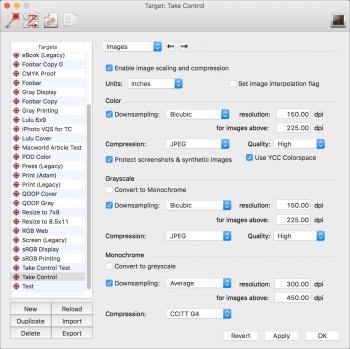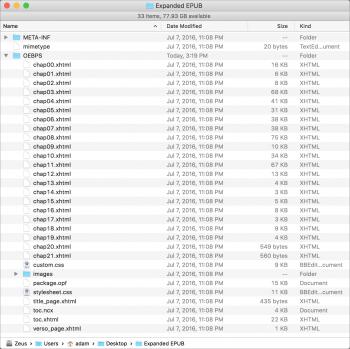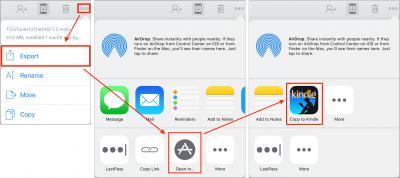We release all Take Control ebooks in three formats: PDF, EPUB, and Mobipocket. PDF is the format we started with back in 2003, and it remains the best option for reading on a computer or a large-screen iPad, since we put significant effort into keeping the text and Associated screenshots together on pages, avoiding widows and orphans, and Creating an attractive two-column layout for our Crash Courses. EPUB Gained popularity after Apple’s release of iBooks, and it’s best for small-screen iOS devices Because it reflows to match the screen and your Desired font size. Mobipocket, Generally abbreviated to just mobile, is similar to EPUB, but is relevant only for Those Who Prefer to read on one of Amazon’s Kindle devices or apps.
How popular would you expect each of These to ask? We tracked the downloads sometime recently and Found That about 55 percent of the downloads were PDF, about 35 percent were EPUB, and about 8 percent were Mobi. (These numbers are a bit rough Because people can download multiple formats.)
Since Mobi is our least used format, and since issues That Affect the EPUB Generally apply to the Mobi as well, we put less effort into checking and tweaking the Mobile version of each book. Nonetheless, we were a little surprised recently to get email from a reader complaining That the Mobile Version of “Take Control of iTunes 12: The FAQ” was too big to copy to a Kindle. Could it really havebeen That much larger than our other books? Some research was Necessary.
It turns out That 50 MB is the magic filesize of Which Amazon’s Send to Kindle app and Send to Kindle email service refuse to work. Only three of our books had ever exceeded That size, with “Take Control of Preview” and “iOS 9: A Take Control Crash Course” joining the iTunes book. “Photos for Mac: A Take Control Crash Course” snuck under the wire at 49.6 MB.
File Format Background – Why were the Mobi files so large? The Mobi file for the iTunes book was 53.4 MB, but the EPUB was only 21.9 MB, and the PDF weighed in at a svelte 6.4 MB. A little background about each format will explain the difference.
-
PDF Since PDF was first released in 1993, When networks were much slower and storage devices much smaller, Reducing the size of PDF files was an important issue. As a result, Adobe has long provided tools in Acrobat Pro to Reduce the size of images Automatically by downsampling and compressing them. Those capabilities are extremely Effective, dropping the source PDF of the iTunes book from 28.2 MB to 6.4 MB, a savings of 77 percent.
We use Apago’s PDF Enhancer to optimize our PDFs in a variety of ways while still Keeping the quality high. (PDF Enhancer has not been updated in years, but it Continues to work well for us. Many of its capabilities are a translation of the Acrobat Pro, albeit in a form That requires more manual intervention.)
-

-
EPUB: at its heart, an EPUB is actually a Web site made up of HTML files and images, all the Zip compressed into a single file. Unfortunately, lossless Zip Compression Does Not necessarily do a lot for what is Essentially a Web site, so the files That make up the EPUB of the iTunes book are 23 MB, but the EPUB itself is only 5 percent smaller, at 21.9 MB.
-

-
Mobile Mobipocket was Quantity by Amazon in 2005 and has changed quite a bit since then. Nowadays, a Mobi file contains the book in two formats, the original Mobipocket version (actually Amazon’s AZW format, Which is very slightly modified Mobipocket) and Amazon’s KF8, also known as AZW3, Which debuted alongside the first Kindle Fire tablet. Since most Mobi files are created from an EPUB source document by Amazon’s KindleGen tool, bundling two versions of the book Into the Same file MEANS That the Mobi ice Generally Roughly twice the size of the EPUB.
Working around the 50 MB Problem – Now that we’re aware of the Send to Kindle 50MB limitation, we’ll try to ENSURE That our books do not Exceed this size. The Solution To That is quite simple.
We take our screenshots in PNG format, Which is ideal for images with large areas of solid color. However, screenshots That show the Mac’s desktop or the iPad’s lock screen, for instance, are Essentially photos, and converting Those PNG files to JPEG can drop the size Significantly without a perceptible loss of quality. Converting the five or six Largest images in the iTunes book to JPEG, and then regenerating the Mobi file were all that was Necessary to bring it down in size. (We did the Sami With The Preview book.)
Should We Have A Book That Can not Easily be brought below 50 MB, or if You should run into a .mobi file from another source that’s larger than 50 MB, there are other ways you can load the files onto a Kindle or into the Kindle app.
-
Kindle: For a Kindle tablet, connect the device to your Mac via a USB cable. A KINDLE disk Appear on the Desktop. Open it, and then copy the .mobi file to the Documents folder inside. KINDLE Eject the disk and then look for your file in the Docs Part of the Kindle interface. Do not put files into the Books folder; That will not work.
-
Kindle Apps: If you prefer to Maintain your ebook library in the Kindle app on an iOS device, the trick is to use your Mac to put a copy in Dropbox, Google Drive or iCloud Drive and then download it into the Corresponding app on the iOS device.
in Dropbox, once you’ve loaded the document, tap the triple-dot More button, tap Export in the popover, tap Open in in the bottom row in the Share sheet, and then tap Copy to Kindle in the top row of the Share sheet.

The process is very similar in Google Drive; up iCloud Drive, Copy to Kindle Appears in the top row of the first Share sheet, Eliminating the Need for the Open in step.
You might wonder why I do not recommend downloading from your Take Control library to a Kindle Fire. The Reason Is that downloaded files end up in KINDLE / Download and must be moved into the KINDLE / Documents manually, using an app like File Expert. The instructions in “How to Download EPUB, PDF, and Mobipocket to the Kindle Fire” (22 April 2012) are still accurate, although File Expert Does not seem to be available any longer, so you’ll need to find another filemanagement app to move downloaded files.
I Suspect That Amazon limits the file size to 50 MB for Historical Reasons related to the low-throughput Whispernet Networkthat the early Kindles used. My understanding is That When The Send to Kindle app or email service transfers the actual file to a Particular Kindle, it sends only the style That makes sense for That device. But in a world of fixed Wi-Fi, this limitation Seems annoyingly quaint – here’s hoping That Amazon lifts it soon.
In the meantime, you can work around the restriction with a USB connection or an Internet filesharing service.
![]()
No comments:
Post a Comment